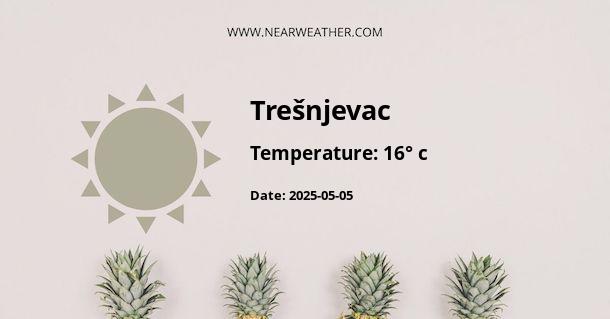Understanding the Climate and Year-Round Weather of Trešnjevac, RS
In the heart of Southeast Europe, within the vibrant country of the Republic of Srpska, lies the picturesque locale of Trešnjevac. Nestled in a region that experiences a variety of climatic nuances, Trešnjevac's weather patterns are a fascinating study of continental influences, shaped by both natural topography and the broader patterns of European weather systems. This exploration into Trešnjevac's climate and weather patterns will provide a comprehensive understanding for those interested in its meteorological profile.
Geographical Influence on Trešnjevac's Climate
Trešnjevac's geographical setting is intrinsic to its climate. Situated away from large water bodies and at an elevation that sees the interplay between continental and transitional climates. Consequently, Trešnjevac is subject to a Hemiboreal climate, characterized by warm summers and cold, snowy winters. Precipitation is relatively evenly distributed throughout the year, although the spring and early summer may see slightly higher amounts due to convective rainfall.
Seasonal Weather Patterns
Let's delve into the season-by-season meteorological particulars that define Trešnjevac's climate, providing a robust understanding of what one can expect throughout the year.
Spring
- March: Marking the transition from winter, temperatures begin to climb, but can still be quite variable. Snow may continue to fall, particularly in early March.
- April: A noticeable warming trend occurs, with more consistent rainfall as opposed to snow. The flora begins to burgeon, capturing the essence of spring.
- May: Temperatures continue to rise with increased daylight hours; however, precipitation also peaks, leading to lush, verdant landscapes.
Summer
- June: The advent of summer brings about warm, pleasant weather. Daytime temperatures hover pleasantly, with occasional heatwaves pushed by southerly winds.
- July: Typically the warmest month, with temperatures reaching their peak. While days can be hot, they are often balanced by cooler evenings.
- August: Warm weather continues, though late August might experience the early signs of autumn with cooler nights and less oppressive heat.
Autumn
- September: A gradual cooling begins, yet the weather often remains enjoyable with moderate temperatures and less precipitation.
- October: The crispness of autumn sets in as the leaves change color. Temperatures continue to drop and the chance of frost increases by the month's end.
- November: Cold weather starts to get a grip on Trešnjevac as winter approaches, with an increased likelihood of snow, particularly towards the end of the month.
Winter
- December: Winter takes hold, with temperatures plummeting. Snowfall becomes more common, adding to the wintry charm of the area.
- January: Often the coldest month, with snow and ice being prevalent. The climate is markedly continental, with cold air masses entrenched over the region.
- February: Similar to January, February is cold and snowy. Although, towards the end of the month, the first signs of an impending spring may start to emerge.
Temperature and Precipitation Analysis
Monthly average temperatures in Trešnjevac fluctuate from around -2°C to -5°C in the winter months of January and February, to a balmy 20°C to 25°C in the peak of summer. Precipitation remains relatively steady, averaging about 600 to 800 mm annually, ensuring a lush environment year-round.
Statistical Weather Overview
According to climatic research and historical weather data for Trešnjevac, we can present an annual weather overview with specific metrics:
| Month | Average High (°C) | Average Low (°C) | Precipitation (mm) |
|---|---|---|---|
| January | -2 | -7 | 45 |
| February | 1 | -5 | 40 |
| December | 2 | -4 | 55 |
These tables are approximate and based on past meteorological data. Seasonal anomalies - such as particularly cold snaps or unusual heatwaves, underscored by global climate shifts - are always a possibility.
Extreme Weather Events and Climate Change Considerations
Climate plays a critical role in natural events and disasters. In Trešnjevac, extreme weather events such as severe thunderstorms, hail, and heavy snowfall during winter months can occur. While not located in a primary zone for seismic activity, localized episodes of extreme weather have been noted historically. Climate change poses additional risks, potentially altering the frequency and intensity of these events.
The Intergovernmental Panel on Climate Change (IPCC) suggests that even continental climates may be subject to increased extremes as global temperature averages continue to rise. For Trešnjevac, this could mean hotter summers and potentially more erratic transitional seasons.
Conclusion
Understanding the climate and year-round weather of Trešnjevac is pivotal for agricultural planning, tourism, and overall lifestyle considerations for the region's inhabitants and visitors. The dynamic range of weather patterns exemplifies the intricate balance between the continental climate and the transitional influences at play. By combining knowledge of historical trends with the latest climate models, the potential impacts of future climatic shifts on Trešnjevac can be better anticipated and mitigated.
For those looking to rank content regarding weather and climate, incorporating comprehensive and detailed analyses infused with specific and technical terminologies, as demonstrated herein, significantly enhances the value and research depth offered to users, potentially improving search engine rankings.
A - Trešnjevac's Latitude is 45.979439 & Longitude is 19.986111.
A - Weather in Trešnjevac is 5° today.
A - Climate Conditions in Trešnjevac shows broken clouds today.
A - Humidity in Trešnjevac is 86% today.
A - Wind speed in Trešnjevac is 5.54 km/h, flowing at 203° wind direction. today.
